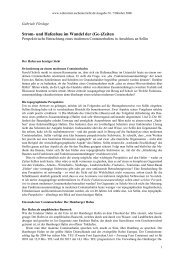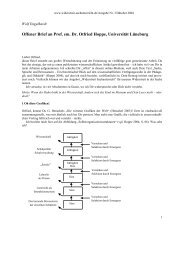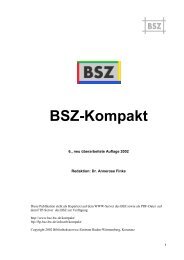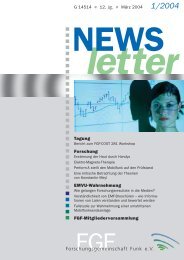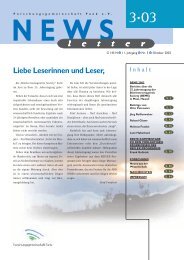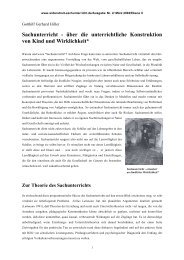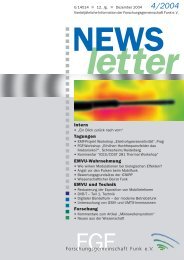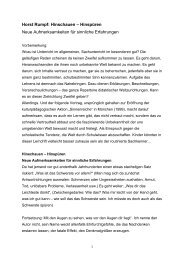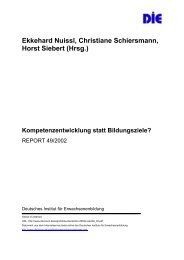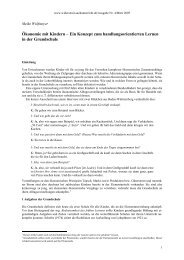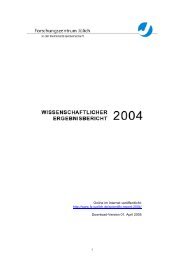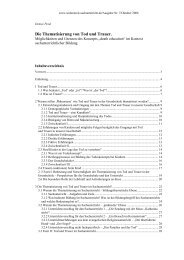Targeted differential display of abundantly expressed sequences ...
Targeted differential display of abundantly expressed sequences ...
Targeted differential display of abundantly expressed sequences ...
You also want an ePaper? Increase the reach of your titles
YUMPU automatically turns print PDFs into web optimized ePapers that Google loves.
A number <strong>of</strong> PCR-based methods for rapidly comparing<br />
pr<strong>of</strong>iles <strong>of</strong> gene expression have been reported. One<br />
such method, <strong>differential</strong> <strong>display</strong> (DDRT-PCR), involves<br />
the random amplification <strong>of</strong> <strong>sequences</strong> from cDNA populations<br />
<strong>of</strong> interest using short oligonucleotide primers in<br />
combination with primers which anneal to the polyA tail<br />
<strong>of</strong> the cDNA; amplification products are then directly compared<br />
on polyacrylamide gels (Liang and Pardee 1992).<br />
Here, the DDRT-PCR approach has been modified to<br />
screen specifically for <strong>sequences</strong> containing regions encoding<br />
CBDs from P. chrysosporium, after growth on three<br />
different carbon (C) sources. In this case, the short primers<br />
used for DDRT-PCR are replaced by longer degenerate<br />
primers designed to anneal to a conserved region <strong>of</strong> the<br />
CBD-encoding sequence, allowing the annealing temperature<br />
<strong>of</strong> the PCR reaction to be elevated, and thus to be<br />
more specific. CBDs are present in the majority <strong>of</strong> fungal<br />
cellulases studied to-date and have also been reported in a<br />
xylanase from H. insolens (Dalbøge and Heldt-Hansen<br />
1994), a β mannanase (Stålbrand et al. 1995) and an acetyl<br />
xylan esterase (Margolles-Clark et al. 1996) from T. reesei.<br />
Materials and methods<br />
Organism and culture media. P. chrysosporium ME446 (ATCC<br />
34541) was maintained on 2% (w/v) slopes malt-extract agar. The<br />
culture medium was a modified Vogel’s medium as described previously<br />
(Tempelaars et al. 1994), containing 0.2% (w/v) <strong>of</strong> a carbon<br />
source from Avicel (microcrystalline cellulose), carboxymethyl cellulose<br />
(CMC) (amorphous cellulose) or oatspelt arabinoxylan.<br />
DNA manipulations. DNA was extracted from P. chrysosporium as<br />
described by Raeder and Broda (1985). Southern blotting was onto<br />
Hybond N membrane (Amersham) and hybridisation was performed<br />
using the low-stringency conditions described in Sambrook et al.<br />
(1989). All techniques referred to below were according to the<br />
manufacturers’ recommendations. Colony hybridisations were made<br />
on Hybond C extra membrane (Amersham). PCR-amplified DNA<br />
fragments were purified for cloning using the Promega Wizard PCR<br />
Preps kit. PCR-amplified DNA was cloned using the pGEM-T vector<br />
cloning kit (Promega) and transformed into Stratagene Ultracompetent<br />
Epicurian coli XL2-blue MRF′ cells. Plasmid preparations<br />
were made using the Qiagen Plasmid Miniprep kit. Sequencing <strong>of</strong><br />
cloned PCR products was performed using the ABI PRISM Dye Terminator<br />
cycle sequencing kit <strong>of</strong> Perkin Elmer. The 32 P-radiolabelled<br />
probe DNA was prepared using the Random Primed Labelling kit <strong>of</strong><br />
Pharmacia.<br />
RNA extraction and cDNA synthesis. P. chrysosporium was inoculated<br />
into liquid culture as previously described and the mycelium<br />
was harvested after 4-days stationary incubation at 37°C (Tempelaars<br />
et al. 1994). The mycelium was ground under liquid nitrogen<br />
and RNA extracted using the Qiagen RNeasy kit. Poly (A) + mRNA<br />
was purified from this with a Dynal’s Dynabeads mRNA extraction<br />
kit. cDNA was synthesised from mRNA with the Pharmacia First-<br />
Strand cDNA synthesis kit, using the NotI primer supplied with the<br />
kit.<br />
Design <strong>of</strong> PCR primers and RT-PCR conditions for targeted <strong>differential</strong><br />
<strong>display</strong>. Figure 4 shows an alignment <strong>of</strong> the amino-acid <strong>sequences</strong><br />
<strong>of</strong> 30 previously published fungal CBD regions. From amino-acid<br />
positions 2–8, 25 <strong>of</strong> these vary only at position 7, involving<br />
<strong>sequences</strong> GQCGGI/N/QG. Three degenerate oligonucleotide primers<br />
were designed to anneal to DNA <strong>sequences</strong> coding for these regions.<br />
Primer 1 (5′-GGNCAGTGCGGNGGNATPyGG-3′) anneals<br />
to <strong>sequences</strong> coding for GQCGGIG, primer 2 (5′-GGNCAGTGC<br />
GGNGGNCAGGG-3′) anneals to <strong>sequences</strong> coding for GQCGGQG,<br />
and primer 3 (5′-GGNCAGTGCGGNGGNAAPyGG-3′) anneals to<br />
<strong>sequences</strong> coding for GQCGGNG. On the basis <strong>of</strong> codon usage in<br />
known P. chrysosporium genes, the codon CAG was employed for<br />
amino-acid Q. Each <strong>of</strong> these primers was used independently in<br />
DDRT-PCR reactions with a primer which anneals to the poly-A tail<br />
(5′-ATTCGCGGCCGCAGGAT 15 ), which is derived from the Pharmacia<br />
NotI dT primer used for cDNA synthesis. Primer 4<br />
(5′-GCACTGCGAGTAGTA-3′) was used in combination with primer<br />
1 to PCR-amplify the region coding for the CBD from the cbhI.1<br />
gene <strong>of</strong> P. chrysosporium, cloned in 3E2D (Sims et al. 1994). The<br />
cbhII upstream primer, 5′-CCTCAGCCCTTACTACGC-3′, was as<br />
used for RT-PCR in Tempelaars et al. (1994) with an annealing temperature<br />
<strong>of</strong> 55°C. To prevent primers 1–3 acting as RAPD primers,<br />
generating PCR products in the absence <strong>of</strong> any other primer, an annealing<br />
temperature <strong>of</strong> 65°C was employed. The RT-PCR conditions<br />
were: one cycle <strong>of</strong> 94°C for 1 min, 65°C for 1 min, 72°C for 2 min;<br />
30 cycles <strong>of</strong> 94°C for 30 s, 65°C for 30 s, 72°C for 1.5 min, and a<br />
cycle <strong>of</strong> 72°C for 10 min.<br />
Results<br />
Isolation <strong>of</strong> cDNA <strong>sequences</strong> which hybridise<br />
to the CBD-encoding region <strong>of</strong> cbhI.1<br />
from P. chrysosporium ME446<br />
71<br />
P. chrysosporium was grown for 4 days at 37°C in medium<br />
containing either Avicel, CMC, or oatspelt arabinoxylan.<br />
The rationale for choosing these C sources is that Avicel<br />
is commonly regarded as an exocellulase substrate, CMC<br />
as an endocellulase substrate, while xylan is the major component<br />
<strong>of</strong> hemicellulose; the expression <strong>of</strong> different components<br />
<strong>of</strong> the lignocellulolytic system has been shown to<br />
occur after growth on each (Broda et al. 1995). cDNA was<br />
synthesised from poly (A) + mRNA prepared from mycelia<br />
grown on each medium and, in each case, 50 ng was<br />
used in PCR reactions containing either CBD primer 1, 2<br />
or 3, each in combination with an oligo-dT primer which<br />
anneals specifically to the poly-A tail <strong>of</strong> cDNA.<br />
Initially, however, to test whether, under all conditions,<br />
intact mRNA had been extracted and converted to cDNA,<br />
RT-PCR was performed using a primer which anneals to<br />
the cbhII gene <strong>of</strong> P. chrysosporium in combination with<br />
the oligo-dT primer. This cellulase gene is <strong>expressed</strong> after<br />
growth on Avicel, CMC, and xylan (Tempelaars et al. 1994)<br />
and thus cDNA derived from it should be detected in each<br />
sample. This proved to be the case, and a PCR product <strong>of</strong><br />
a size expected from cbhII cDNA using these primers, approximately<br />
1.4 kb, was generated from each cDNA sample,<br />
whereas no such product was generated from genomic<br />
DNA (Fig. 1).<br />
To test whether the products amplified, using CBD<br />
primers 1, 2 or 3 with the oligo-dT primer, contained <strong>sequences</strong><br />
which share homology with a CBD-encoding region,<br />
each population <strong>of</strong> PCR products was separated by<br />
gel electrophoresis. These were then Southern blotted and<br />
hybridised, using low-stringency conditions, to a probe derived<br />
from the P. chrysosporium cbhI.1 gene. To prepare




